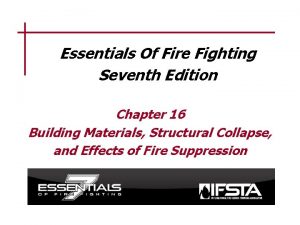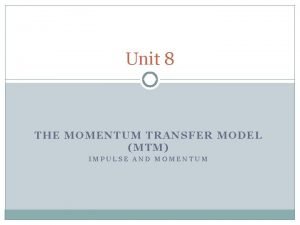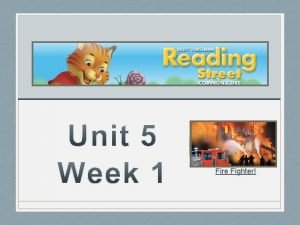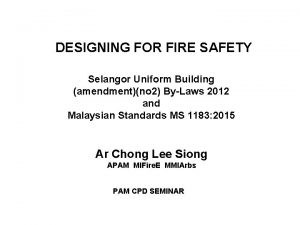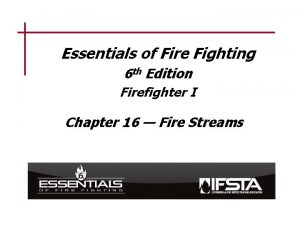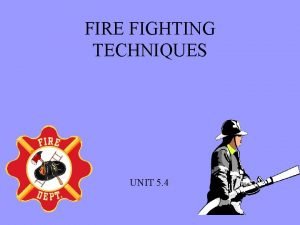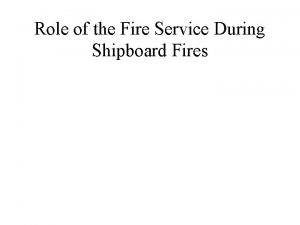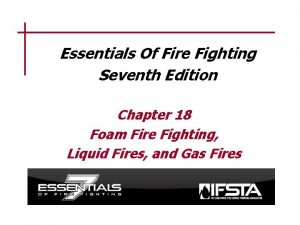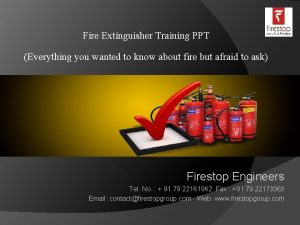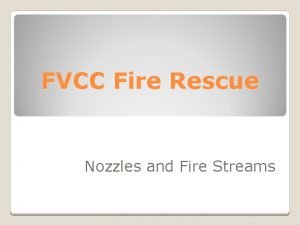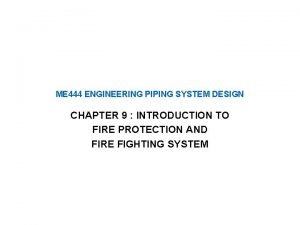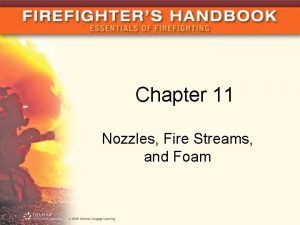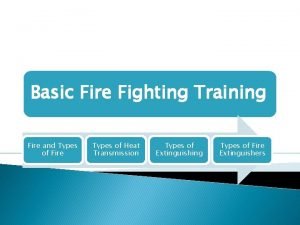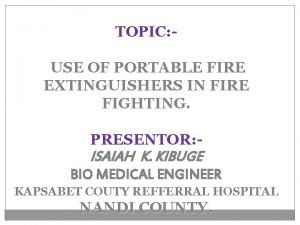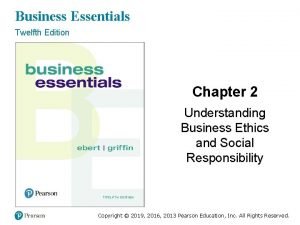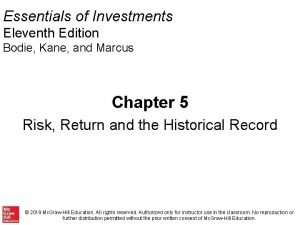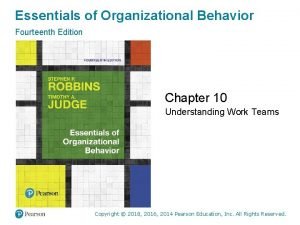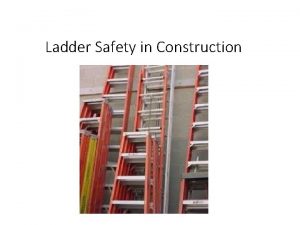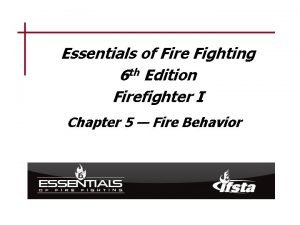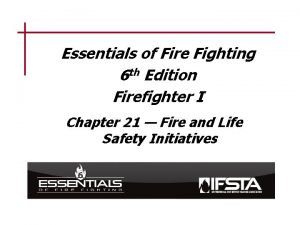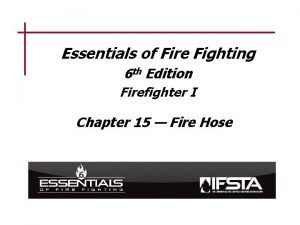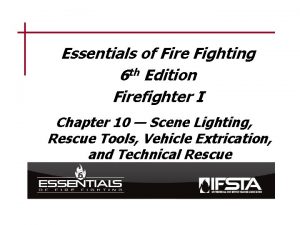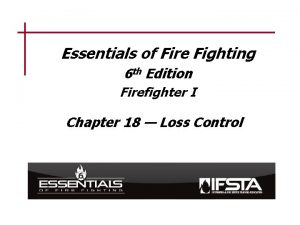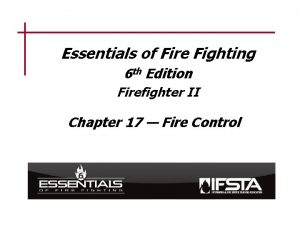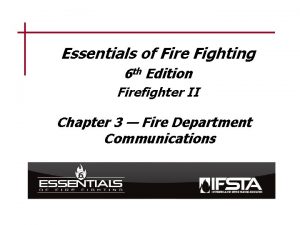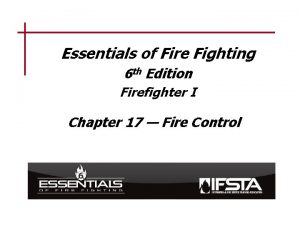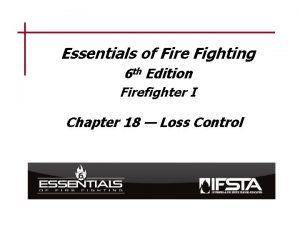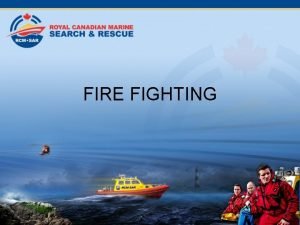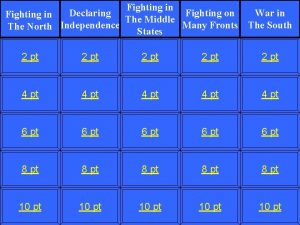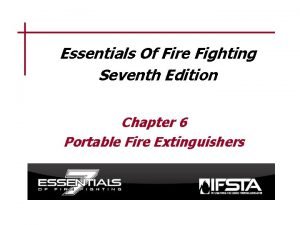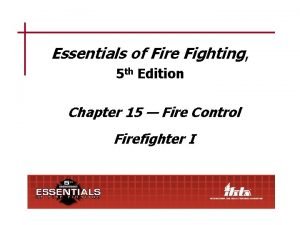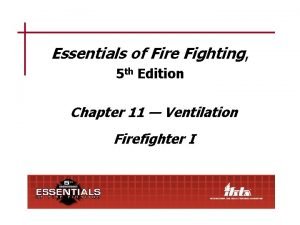Essentials of Fire Fighting 6 th Edition Firefighter
































- Slides: 32


Essentials of Fire Fighting 6 th Edition Firefighter I Chapter 2 — Firefighter Safety and Health

Learning Objective 1 List the main types of job-related firefighter fatalities, injuries, and illnesses. 2– 3

Firefighter fatalities are caused by a variety of situations. Leading causes Remaining causes • Stress or overexertion • Motor vehicle accidents • Falls • Being struck by an object • Being trapped in structure fire • Gunshot wounds while tending medical patient 2– 4

Firefighter injuries occur both on the fireground at nonfire emergencies. Main types Strains and sprains Other During training Cuts and bruises Nonemergency incidents Responding to or returning from incidents Other on-duty activities 2– 5

Firefighter injuries cause costs to both individuals and departments. Individual Career department Volunteer department Physical pain Lost duty time Possible worker’s comp Emotional stress Worker’s comp No wages for FF from full-time job No wages for FF 2– 6

The shared costs of injuries can be prevented by both the individual and organization. Effective training Company discipline and accountability Use PPE properly Physical fitness Follow established safety SOPs Follow risk management 2– 7 Use rehab at incidents

You must be aware of and protect yourself from certain chronic illnesses. Respiratory diseases Obesity Cancer Cardiovascular diseases (Cont. ) 2– 8

You must be aware of and protect yourself from certain chronic illnesses. Exposurerelated disease Stressinduced hypertension Drug and alcohol use Tobacco use/ dependence Diabetes 2– 9

REVIEW QUESTION What types of job-related injuries and illnesses can a firefighter expect to encounter? 2– 10

Learning Objective 2 Describe the National Fire Protection Association® standards related to firefighter safety and health. 2– 11

Fire service safety is governed by several standards, regulations, and initiatives. NFPA® OSHA Can. OSH Annual Safety Stand-down Everyone Goes Home® 2– 12

NFPA® standards establish and regulate many aspects of safety. Establish design criteria for protective clothing and equipment Define safe training practices and programs Set requirements for care and maintenance of personal and respiratory protection equipment Establish safety programs departments must adopt 2– 13

NFPA® 1500 is the most comprehensive standard relating to safety and health. Safety and health-related policies Safety and healthrelated policies Training and education Driver/operator (Cont. ) 2– 14

NFPA® 1500 is the most comprehensive standard relating to safety and health. Emergency operations Facility safety Protective clothing and protective equipment 2– 15 (Cont. )

NFPA® 1500 is the most comprehensive standard relating to safety and health. Member assistance and wellness programs Critical incident stress management Medical and physical requirements 2– 16

REVIEW QUESTION What topics does NFPA® 1500 cover regarding firefighter safety and health? 2– 17

Learning Objective 3 Identify Occupational Safety and Health Administration (OSHA) regulations that relate to firefighters. 2– 18

OSHA regulations apply to specific categories of employees. 2– 19

Other organizations work to reduce fire fatalities and focus on safety. International Association of Fire Chiefs National Fallen Firefighters Foundation Annual Safety Stand -down 2– 20

REVIEW QUESTION Federal OSHA regulations apply to what specific groups of firefighters? 2– 21

Learning Objective 4 Summarize the model that supports the concept of risk management. 2– 22

Risk management establishes criteria to assess benefit and risk at incidents. Will risk a lot to save savable lives Will NOT risk to save lives, property already lost Will risk a little to save savable property 2– 23

REVIEW QUESTION How do the key behaviors of driving defensively, keeping the crew intact, and following standard fireground procedures support the concept of risk management? 2– 24

Learning Objective 5 Describe fire department safety and health programs. 2– 25

Learning Objective 6 Summarize firefighter health awareness issues. 2– 26

Department safety and health programs target specific goals. • Human suffering, fatalities, injuries, illness, exposure Prevent • Damage to or loss of equipment Reduce All levels • Occurrences and severity • Promote and practice safety program 2– 27

Safety and health programs are based on several specific components. Safety and health committee Department policies Accident prevention Training for personnel 2– 28

Health considerations for firefighters begin with adopting a healthy lifestyle. Keys for personal health Good nutrition 2– 29 Physical fitness

REVIEW QUESTION What are the main goals of a safety and health program? 2– 30

Employee assistance and wellness programs offer help in various ways. Employee Assistance Program • Problems that affect job performance Wellness program • Health-related problems 2– 31

REVIEW QUESTION What areas can an Employee Assistance and Wellness program assist with? 2– 32
 Firefighter essentials 7th edition
Firefighter essentials 7th edition Momentum bar chart
Momentum bar chart Fire prefix words
Fire prefix words Ubbl schedule 10
Ubbl schedule 10 Rotary control valve firefighting
Rotary control valve firefighting Fire fighting techniques
Fire fighting techniques Foam pro 1600
Foam pro 1600 Shipboard fire fighting organization
Shipboard fire fighting organization Clean agent fm 200 fire suppression systems in uae
Clean agent fm 200 fire suppression systems in uae At a bulk transport incident, firefighters must:
At a bulk transport incident, firefighters must: Fire safety training powerpoint
Fire safety training powerpoint Physical states
Physical states Condensate pipe sizing chart
Condensate pipe sizing chart Rain down foam application method
Rain down foam application method Tactical ventilation
Tactical ventilation Ship fire fighting equipment
Ship fire fighting equipment Method of fire fighting
Method of fire fighting Ordinary combustible material
Ordinary combustible material Network security essentials 5th edition
Network security essentials 5th edition Business essentials 12th edition chapter 1
Business essentials 12th edition chapter 1 Business essentials 12th edition
Business essentials 12th edition Criminal justice the essentials 5th edition
Criminal justice the essentials 5th edition Essentials of investments 11th edition
Essentials of investments 11th edition Essentials of mis, 13th edition
Essentials of mis, 13th edition Understanding business 12th edition chapter 1
Understanding business 12th edition chapter 1 Types of group
Types of group Network security essentials 5th edition
Network security essentials 5th edition Essentials of sociology 5th edition
Essentials of sociology 5th edition Using mis 10th edition
Using mis 10th edition Report
Report Neo luddite criticisms of computer technology
Neo luddite criticisms of computer technology A gift of fire 4th edition
A gift of fire 4th edition Step ladder
Step ladder
